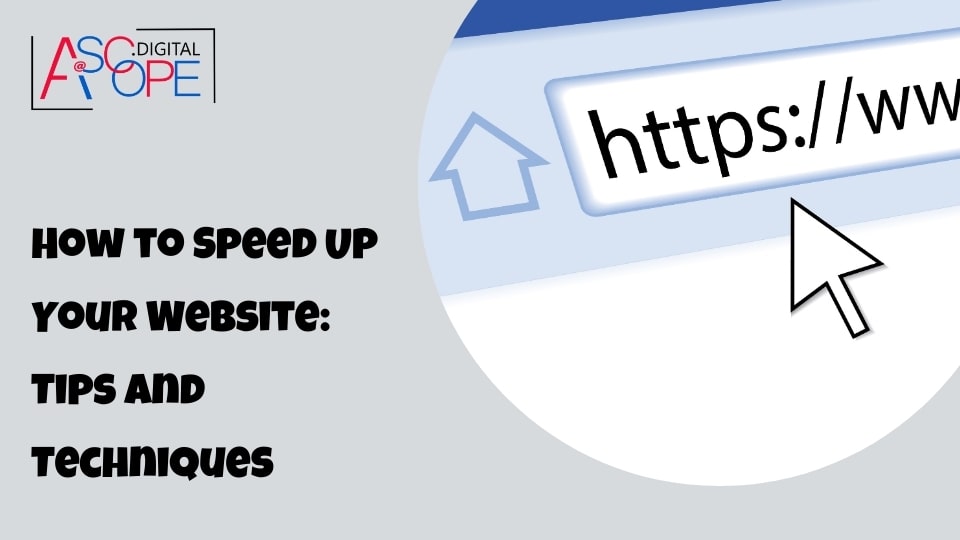In today’s digital age, the speed of your website can make or break your online success. Slow websites frustrate users, lead to higher bounce rates, and can even affect your search engine rankings. This comprehensive guide will explore various tips and techniques to speed up your website, ensuring it delivers a fast and seamless experience for your visitors.
Understanding Website Speed

Website speed refers to how quickly web pages load in a browser. It encompasses various aspects, including server response time, file sizes, and browser rendering. A faster website improves user experience, increases conversion rates, and enhances SEO performance. Let’s delve into specific techniques to achieve optimal website speed.
Optimize Images
Images significantly contribute to the size of a web page. To optimize images, start by compressing them without compromising quality. Tools like TinyPNG and JPEG Optimizer can help reduce image sizes. Additionally, use the appropriate file formats; for example, JPEGs for photographs and PNGs for graphics with transparent backgrounds. Implementing lazy loading ensures images load only when they enter the viewport, reducing initial load time.
Minimize HTTP Requests
Each element on a web page, including images, scripts, and stylesheets, requires an HTTP request. Reducing the number of these requests speeds up your site. Combine CSS and JavaScript files, use CSS sprites for icons, and eliminate unnecessary plugins and widgets. Streamlining your site’s design to include only essential elements can significantly enhance load times.
Enable Browser Caching
Browser caching stores static files from your website on a user’s device, allowing faster access upon subsequent visits. Configure caching headers to specify the duration files should be stored. Implementing caching through .htaccess files or using plugins for CMS platforms like WordPress can effectively reduce load times for returning visitors.
Leverage Content Delivery Networks (CDNs)
A CDN distributes your website’s content across multiple servers worldwide, reducing the distance data travels to reach users. This decreases latency and speeds up load times. Popular CDN services like Cloudflare and Amazon CloudFront can cache static content and serve it from the nearest server to the user, ensuring faster delivery.
Optimize CSS and JavaScript
Large CSS and JavaScript files can slow down your website. Minify these files by removing unnecessary spaces, comments, and code. Tools like UglifyJS for JavaScript and CSSNano for CSS can automate this process. Additionally, defer the loading of JavaScript files that are not required immediately, ensuring they load after the main content.
Implement Asynchronous Loading
Asynchronous loading allows multiple scripts to load simultaneously, rather than sequentially. This can significantly improve load times. By adding the “async” attribute to your script tags, you enable asynchronous loading, ensuring scripts do not block the rendering of other elements on the page.
Reduce Server Response Time
Server response time plays a crucial role in website speed. To reduce response time, choose a reliable hosting provider with fast servers. Implement server-side caching, such as using caching plugins for WordPress or enabling opcode caching for PHP. Regularly monitor your server’s performance and address any bottlenecks promptly.
Optimize Web Fonts

While web fonts enhance your site’s aesthetics, they can also increase load times. Optimize web fonts by using only the required character sets and font weights. Consider using system fonts that do not require downloading. Tools like Font Squirrel’s Web Font Generator can help you create optimized font files.
Enable Compression
Compressing files reduces their size, leading to faster load times. Gzip compression is commonly used to compress HTML, CSS, and JavaScript files. Enable Gzip compression on your server or use plugins available for CMS platforms. This ensures that files are delivered to users in a compressed format, which their browsers then decompress.
Prioritize Above-the-Fold Content
Above-the-fold content is the portion of the webpage visible without scrolling. Prioritize loading this content first to improve perceived load times. Use techniques like lazy loading for below-the-fold content and inline critical CSS to render above-the-fold content quickly.
Utilize Accelerated Mobile Pages (AMP)
AMP is a framework designed to create fast-loading mobile pages. Implementing AMP can significantly speed up your mobile site. It restricts the use of certain scripts and prioritizes speed, ensuring mobile users experience faster load times. Use AMP plugins or follow Google’s guidelines to implement AMP on your website.
Reduce Redirects
Each redirect creates additional HTTP requests, slowing down your site. Minimize redirects by eliminating unnecessary ones and ensuring your URL structure is clean and efficient. Use tools like Screaming Frog to identify and fix redirect chains and loops.
Optimize Database Performance
For dynamic websites, database performance is critical. Optimize your database by regularly cleaning up unnecessary data, such as spam comments and post revisions. Use indexing to speed up query execution and consider database caching solutions like Redis or Memcached.
Monitor and Analyze Performance
Regularly monitoring your website’s performance helps identify issues and track improvements. Use tools like Google PageSpeed Insights, GTmetrix, and Pingdom to analyze your site’s speed and receive recommendations for optimization. Continuous monitoring ensures you stay ahead of any performance bottlenecks.
Implement HTTP/2
HTTP/2 is a major revision of the HTTP protocol, offering significant speed improvements over HTTP/1.1. It allows multiple requests to be sent over a single connection, reducing latency. Ensure your server supports HTTP/2 and enable it to take advantage of its performance benefits.
Optimize CSS Delivery
Avoid using @import for CSS files, as it creates additional HTTP requests. Instead, use <link> tags to load CSS files. Additionally, consider inlining critical CSS directly in the HTML to ensure it loads faster.
Use Prefetching, Preloading, and Preconnecting
Prefetching, preloading, and preconnecting are techniques that allow the browser to anticipate and load resources before they are needed. Prefetching loads resources that will be used in the near future, preloading fetches resources needed for the current page, and preconnecting establishes early connections to servers. Implementing these techniques can improve load times by reducing the time resources are fetched and connections are made.
Optimize Video Content

Videos can significantly slow down your site if not optimized. Use modern video formats like MP4 and WebM, which offer better compression. Host videos on platforms like YouTube or Vimeo and embed them on your site to reduce server load. Implement lazy loading for videos to ensure they load only when the user interacts with them.
Avoid Inline CSS and JavaScript
Inline CSS and JavaScript can bloat your HTML file and slow down rendering. Instead, keep CSS and JavaScript in external files to improve caching and separation of concerns. This practice also makes your code easier to maintain and debug.
Remove Render-Blocking Resources
Render-blocking resources delay the rendering of web pages. To optimize, defer or asynchronously load JavaScript, and move CSS to the top of the page. Tools like Google PageSpeed Insights can help identify and resolve render-blocking resources.
Optimize Your CMS
Content Management Systems (CMS) like WordPress can become sluggish if not optimized. Regularly update your CMS and plugins to ensure they run efficiently. Use lightweight themes and avoid excessive plugins that can slow down your site. Consider using a managed hosting service that offers optimized environments for your CMS.
Utilize Server-Side Rendering (SSR)
Server-Side Rendering (SSR) generates the HTML of your web pages on the server rather than in the browser. This can significantly speed up the initial load time, especially for dynamic content. Frameworks like Next.js for React and Nuxt.js for Vue offer built-in support for SSR.
Implement Progressive Web Apps (PWA)
Progressive Web Apps (PWAs) offer a fast and reliable user experience by caching assets and enabling offline access. Implementing PWA features can improve load times and provide a seamless experience, even on slow networks. Use service workers to cache resources and ensure your PWA meets Google’s Lighthouse performance criteria.
Use Efficient Coding Practices
Efficient coding practices contribute to a faster website. Avoid duplicate code, use shorthand properties, and follow best practices for writing clean and maintainable code. Regularly refactor your codebase to remove unused or outdated code.
Optimize Third-Party Scripts
Third-party scripts, such as ads and social media widgets, can slow down your site. Audit these scripts and remove any that are not essential. Load third-party scripts asynchronously or defer them to ensure they do not block rendering.
Reduce DNS Lookups
Each DNS lookup adds latency to the load time. Reduce the number of unique domains your site uses to minimize DNS lookups. Tools like DNSStuff can help you analyze and optimize your DNS settings.
Implement HTTP/3
HTTP/3 is the latest version of the HTTP protocol, offering improved performance over HTTP/2. It uses QUIC, a transport layer protocol, to reduce latency and improve security. Ensure your server supports HTTP/3 and enable it to take advantage of its benefits.
Optimize for Mobile Devices
Mobile users expect fast load times. Optimize your site for mobile by using responsive design, optimizing images for mobile, and minimizing resource-heavy elements. Tools like Google’s Mobile-Friendly Test can help ensure your site performs well on mobile devices.
Use Heatmaps and Analytics
Understanding how users interact with your site can help identify performance bottlenecks. Use heatmaps and analytics tools to analyze user behavior and optimize high-traffic areas for speed. Making data-driven decisions ensures your optimization efforts have the most significant impact.
Regularly Review and Update Content
Outdated content and files can bloat your website. Regularly review and update your content, removing anything that is no longer relevant. This practice not only improves speed but also keeps your site fresh and engaging for visitors.
Monitoring and Continuous Improvement
Once you have implemented various optimization techniques, it’s crucial to monitor the performance of your website continuously. Use tools like Google Analytics, PageSpeed Insights, and GTmetrix to track load times, bounce rates, and user engagement. Regularly check for new updates and improvements in web technologies that can further enhance your site’s speed. Address any issues promptly, and don’t hesitate to A/B test different strategies to find what works best for your audience. By consistently monitoring and refining your website’s performance, you ensure a fast and smooth user experience, which can significantly impact your business’s success. Thus, improving traffic and sales for your website. Read more on the other reasons why your website isn’t getting traffic. Continuous improvement not only keeps your website competitive but also meets the ever-evolving expectations of your users, ultimately contributing to sustained growth and customer satisfaction.
Conclusion
Speeding up your website is an ongoing process that requires regular monitoring and optimization. By implementing the tips and techniques outlined in this guide, you can ensure your website delivers a fast, seamless experience for your users. A faster website improves user satisfaction, boosts search engine rankings, and increases conversion rates. Invest time in optimizing your website’s performance, and you will reap the benefits of a faster, more efficient online presence


